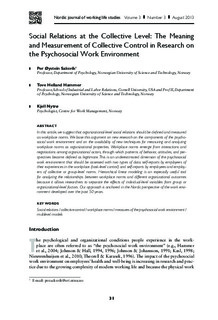| dc.contributor.author | Saksvik, Per Øystein | |
| dc.contributor.author | Hammer, Tove Helland | |
| dc.contributor.author | Nytrø, Kjell | |
| dc.date.accessioned | 2019-10-25T08:49:30Z | |
| dc.date.available | 2019-10-25T08:49:30Z | |
| dc.date.created | 2013-08-21T10:21:21Z | |
| dc.date.issued | 2013 | |
| dc.identifier.citation | Nordic Journal of Working Life Studies. 2013, 3 (3), 31-46. | nb_NO |
| dc.identifier.issn | 2245-0157 | |
| dc.identifier.uri | http://hdl.handle.net/11250/2624378 | |
| dc.description.abstract | In this article, we suggest that organizational-level social relations should be defined and measured as workplace norms. We base this argument on new research on the components of the psychosocial work environment and on the availability of new techniques for measuring and analyzing workplace norms as organizational properties. Workplace norms emerge from interactions and negotiations among organizational actors, through which patterns of behavior, attitudes, and perspectives become defined as legitimate. This is an underestimated dimension of the psychosocial work environment that should be assessed with two types of data: self-reports by employees of their experiences in the workplace (task-level control) and self-reports by employees and employers of collective or group-level norms. Hierarchical linear modeling is an especially useful tool for analyzing the relationships between workplace norms and different organizational outcomes because it allows researchers to separate the effects of individual-level variables from group or organizational-level factors. Our approach is anchored in the Nordic perspective of the work environment developed over the past 50 years. | nb_NO |
| dc.language.iso | eng | nb_NO |
| dc.publisher | Roskilde Universitet | nb_NO |
| dc.relation.uri | http://rossy.ruc.dk/ojs/index.php/njwls/issue/current/showToc | |
| dc.rights | Attribution-NonCommercial-NoDerivatives 4.0 Internasjonal | * |
| dc.rights.uri | http://creativecommons.org/licenses/by-nc-nd/4.0/deed.no | * |
| dc.title | Social Relations at the Collective Level: The Meaning and Measurement of Collective Control in Research on the Psychosocial Work Environment | nb_NO |
| dc.type | Journal article | nb_NO |
| dc.type | Peer reviewed | nb_NO |
| dc.description.version | publishedVersion | nb_NO |
| dc.source.pagenumber | 31-46 | nb_NO |
| dc.source.volume | 3 | nb_NO |
| dc.source.journal | Nordic Journal of Working Life Studies | nb_NO |
| dc.source.issue | 3 | nb_NO |
| dc.identifier.doi | 10.19154/njwls.v3i3.3010 | |
| dc.identifier.cristin | 1044285 | |
| dc.description.localcode | Copyright (c) 2013 Author and Journal Creative Commons License This work is licensed under a Creative Commons Attribution-NonCommercial-NoDerivatives 4.0 International License. | nb_NO |
| cristin.unitcode | 194,67,40,0 | |
| cristin.unitname | Institutt for psykologi | |
| cristin.ispublished | true | |
| cristin.fulltext | original | |
| cristin.qualitycode | 1 | |

